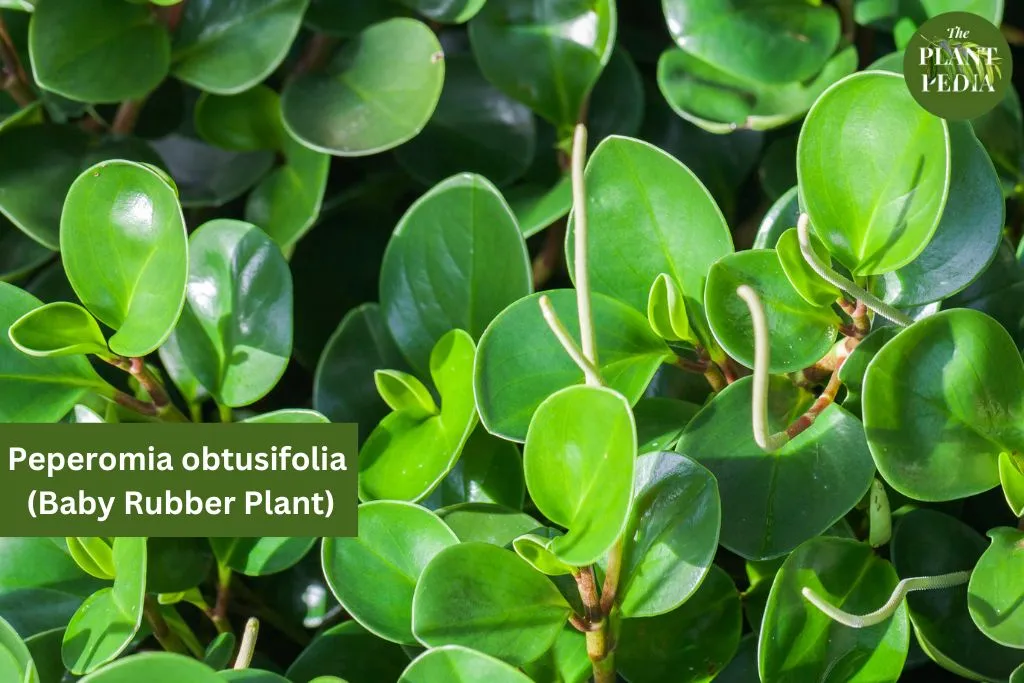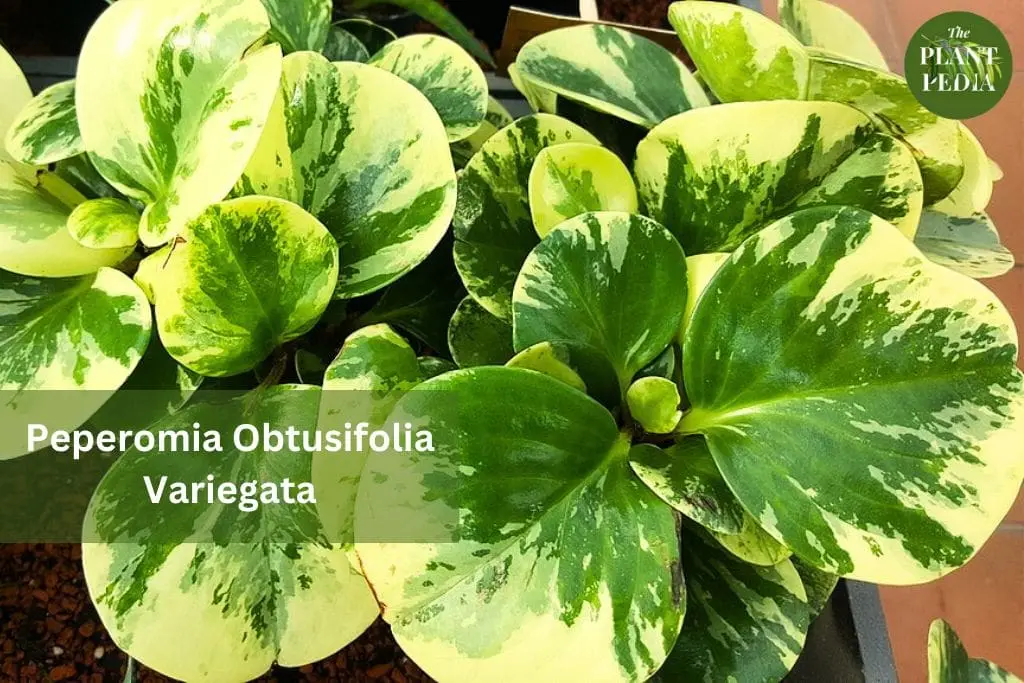The Baby Rubber Plant, scientifically known as Peperomia obtusifolia, is a popular choice among indoor plant enthusiasts.
With its compact size, glossy leaves, and low-maintenance requirements, it’s no wonder this plant has gained a loyal following.
In this comprehensive guide, we will delve deep into the world of Baby Rubber Plant care, exploring everything from its origin and characteristics to proper care techniques, propagation methods, and troubleshooting tips.

Table of Contents
Origin and Characteristics
The Baby Rubber Plant is native to South America, specifically the rainforests of Brazil. It belongs to the Peperomia genus, which comprises over a thousand species of perennial herbs and succulents.
The “rubber” in its common name comes from the thick, rubbery texture of its leaves.
This plant is a favorite for indoor settings due to its manageable size. Its leaves are typically oval-shaped and succulent-like, with a glossy surface that ranges from deep green to variegated patterns of green and cream.
Baby Rubber Plants can reach a height of 10 to 12 inches, making them suitable for tabletops, shelves, and hanging baskets.

Read: Peperomia Obtusifolia Variegata: Everything About This Beauty.
Baby Rubber Plant Care Guidelines
Here are a few most important care guidelines that you must follow if you want to be a good Baby Rubber Plant parent:
Light Requirements
When it comes to light, Baby Rubber Plants prefer moderate to bright indirect light. They can adapt to lower light conditions, but excessive darkness may lead to leggy growth as the plant stretches towards the light source.
On the other hand, too much direct sunlight can scorch their leaves. A balance is crucial. Placing your plant near a north or east-facing window is often ideal.
If you’re using artificial light, consider using a grow light specifically designed for indoor plants.
Read details: Baby Rubber Plant Light Requirements: A to Z Guide.
Watering and Humidity
One of the most significant advantages of caring for a Baby Rubber Plant is its forgiving nature when it comes to watering.
These plants prefer to dry out slightly between waterings, so a good rule of thumb is to water them when the top inch of the soil feels dry to the touch.
Overwatering can lead to root rot, so make sure the pot has proper drainage to prevent water from pooling at the bottom.
As for humidity, Baby Rubber Plants are adaptable and can thrive in average indoor humidity levels.
However, they do appreciate a bit of extra humidity, especially during dry winter months or if you’re in a particularly arid climate.
You can increase humidity by misting the plant or placing a tray of water near it. Just make sure the plant itself doesn’t sit in water to avoid root rot.
Soil and Potting
Choosing the right soil and potting container is essential for the health of your Baby Rubber Plant. A well-draining potting mix is crucial to prevent overwatering and root rot.
You can create a suitable mix by combining potting soil with perlite or orchid bark to improve drainage. A terra cotta pot or any container with drainage holes works well, as it allows excess water to escape.
When repotting, it’s generally recommended to do so every 2-3 years or when you notice the plant becoming root-bound.
Spring is the best time for repotting, as the plant is entering its active growth phase and can quickly recover from the disturbance.
Read details: Peperomia Obtusifolia Soil – The Key to Thriving Baby Rubber Plants.
Temperature and Environment
Baby Rubber Plants prefer temperatures between 65-75°F (18-24°C). They are sensitive to cold drafts and sudden temperature changes, so avoid placing them near doors, windows, or HVAC vents.
Protect them from cold snaps during the winter months, and don’t let the temperature drop below 50°F (10°C).
Read: Baby Rubber Plant Benefits: Greenery with Perks.
Fertilization
Fertilizing your Baby Rubber Plant is essential to provide it with the nutrients it needs for healthy growth.
During the growing season (spring and summer), you can feed your plant with a balanced liquid fertilizer every 4-6 weeks.
It’s essential not to over-fertilize, as this can lead to a buildup of salts in the soil. During the fall and winter, you can reduce the frequency of fertilization to once every 8 weeks.
Read: Baby Rubber Plant Fertilizer: A Detailed Guidelines.
Propagation Techniques
If you’re looking to expand your Baby Rubber Plant collection or share the joy of this plant with friends, propagation is an exciting option.
Here are a few methods you can try:
- Leaf Cuttings: This is one of the most common methods of propagation for Baby Rubber Plants. Simply take a healthy leaf and cut it into sections, making sure each section has a vein. Allow the cuttings to air dry for a day or two to form a callus, then place them in a well-draining potting mix. Keep the soil consistently moist until new growth emerges.
- Stem Cuttings: Similar to leaf cuttings, stem cuttings can also be rooted in soil. Take a healthy stem cutting with a few leaves and allow it to air dry for a day. Plant the cutting in a potting mix and follow the same care routine as with the parent plant.
- Water Propagation: Place leaf or stem cuttings in a container with water, ensuring that at least one node is submerged. Change the water regularly and wait for roots to develop before transplanting the cutting into soil.
- Division: For mature Baby Rubber Plants, division can be a viable propagation method. Gently remove the plant from its pot and separate the root ball into smaller sections, each with its stems and leaves. Repot these sections into individual pots with fresh potting mix.
Read: Baby Rubber Plant Flower: Exploring the Enigmatic Beauty.
Common Issues and Troubleshooting
While Baby Rubber Plants are relatively easy to care for, they can still face a few challenges.
Here are some common issues you might encounter and how to address them:
- Overwatering: If the leaves turn yellow or feel mushy, you might be overwatering. Allow the soil to dry out before watering again, and ensure proper drainage.
- Underwatering: If the leaves are drooping or wrinkling, the plant might be underwatered. Give it a thorough watering and adjust your watering schedule.
- Pests: Baby Rubber Plants can attract pests like mealybugs and spider mites. Regularly inspect your plant for any signs of pests, and if you spot any, isolate the plant and treat it with insecticidal soap or neem oil.
- Leaf Drop: Some leaf drop is natural, especially lower leaves. However, excessive leaf drop can indicate stress, improper watering, or a lack of light. Assess your care routine and adjust as needed.
Read: Is Peperomia Obtusifolia Toxic to Cats? – Baby Rubberplant Toxicity.
Related FAQs:
How often should I water my Baby Rubber Plant?
Baby Rubber Plants prefer to dry out slightly between waterings. As a general guideline, water the plant when the top inch of the soil feels dry to the touch.
Be sure to adjust the frequency based on your home’s humidity, the season, and the size of the pot.
Can I place my Baby Rubber Plant in direct sunlight?
While Baby Rubber Plants can tolerate some direct sunlight, it’s best to avoid placing them in intense, full sun. Direct sunlight can scorch their leaves.
Instead, opt for moderate to bright indirect light, such as near a north or east-facing window.
How do I increase humidity for my Baby Rubber Plant?
Baby Rubber Plants can adapt to average indoor humidity levels, but they appreciate a bit of extra humidity.
You can increase humidity by misting the plant regularly, placing a tray of water near it, or using a humidity tray. Just make sure the plant itself doesn’t sit in standing water.
Can I fertilize my Baby Rubber Plant during the winter months?
While Baby Rubber Plants do have reduced growth during the winter, you can still fertilize them, albeit at a reduced frequency.
Instead of the regular 4-6 weeks during the growing season, fertilize every 8 weeks during the fall and winter to provide the plant with essential nutrients.
How do I prune my Baby Rubber Plant?
Pruning is not usually necessary for Baby Rubber Plants, but you can pinch back leggy growth to encourage bushier growth.
If you want to maintain a compact shape, trim the tips of the stems. Remember that any pruning should be done during the growing season to minimize stress on the plant.
Are Baby Rubber Plants toxic to pets?
Baby Rubber Plants are considered non-toxic to cats, dogs, and humans. However, it’s always a good practice to monitor your pets around plants and discourage them from chewing on any plant material.
What type of potting mix is best for Baby Rubber Plants?
A well-draining potting mix is crucial for Baby Rubber Plants.
You can create a suitable mix by combining regular potting soil with perlite or orchid bark to improve drainage. This prevents overwatering and helps the plant’s roots thrive.
How often should I repot my Baby Rubber Plant?
Baby Rubber Plants generally need repotting every 2-3 years or when you notice the plant becoming root-bound.
Repotting is best done during the spring when the plant is actively growing and can quickly recover from the stress of being transplanted.
Why are the leaves of my Baby Rubber Plant turning yellow?
Yellowing leaves can be caused by various factors, including overwatering, underwatering, or nutrient deficiencies.
Evaluate your watering routine, ensure proper drainage, and consider adjusting your fertilization schedule. It’s also normal for lower leaves to yellow and drop over time.
Can I propagate my Baby Rubber Plant in water?
Yes, Baby Rubber Plants can be propagated in water. You can place leaf or stem cuttings in a container with water, making sure at least one node is submerged.
Change the water regularly, and once roots develop, you can transplant the cutting into soil.
Conclusion
Caring for a Baby Rubber Plant can be a rewarding experience, especially for those new to plant parenting. With its attractive foliage and adaptability, it’s a great addition to any indoor space.
Remember that each plant is unique, so it’s essential to observe your Baby Rubber Plant’s specific needs and adjust your care routine accordingly.
By providing the right light, water, and attention, you’ll be able to enjoy the beauty of your Baby Rubber Plant for years to come.


